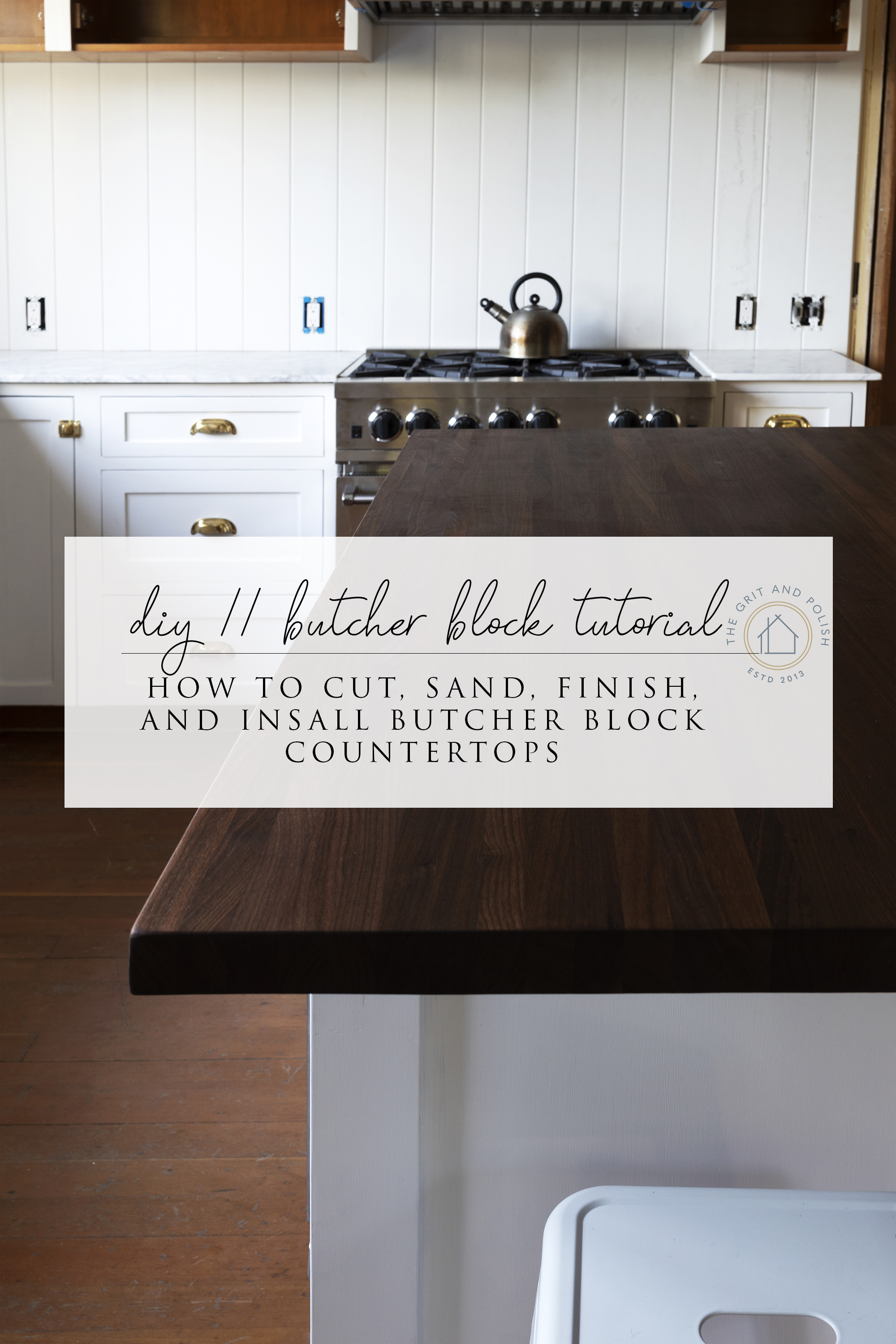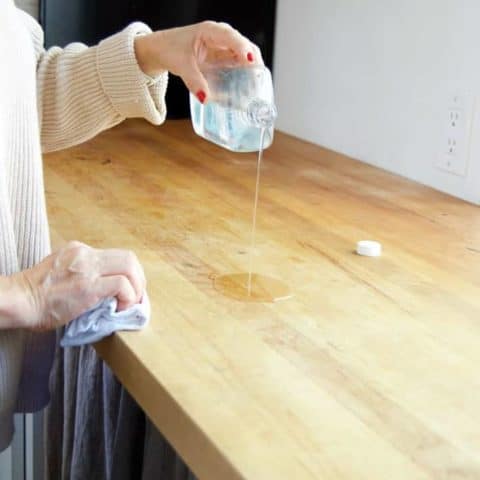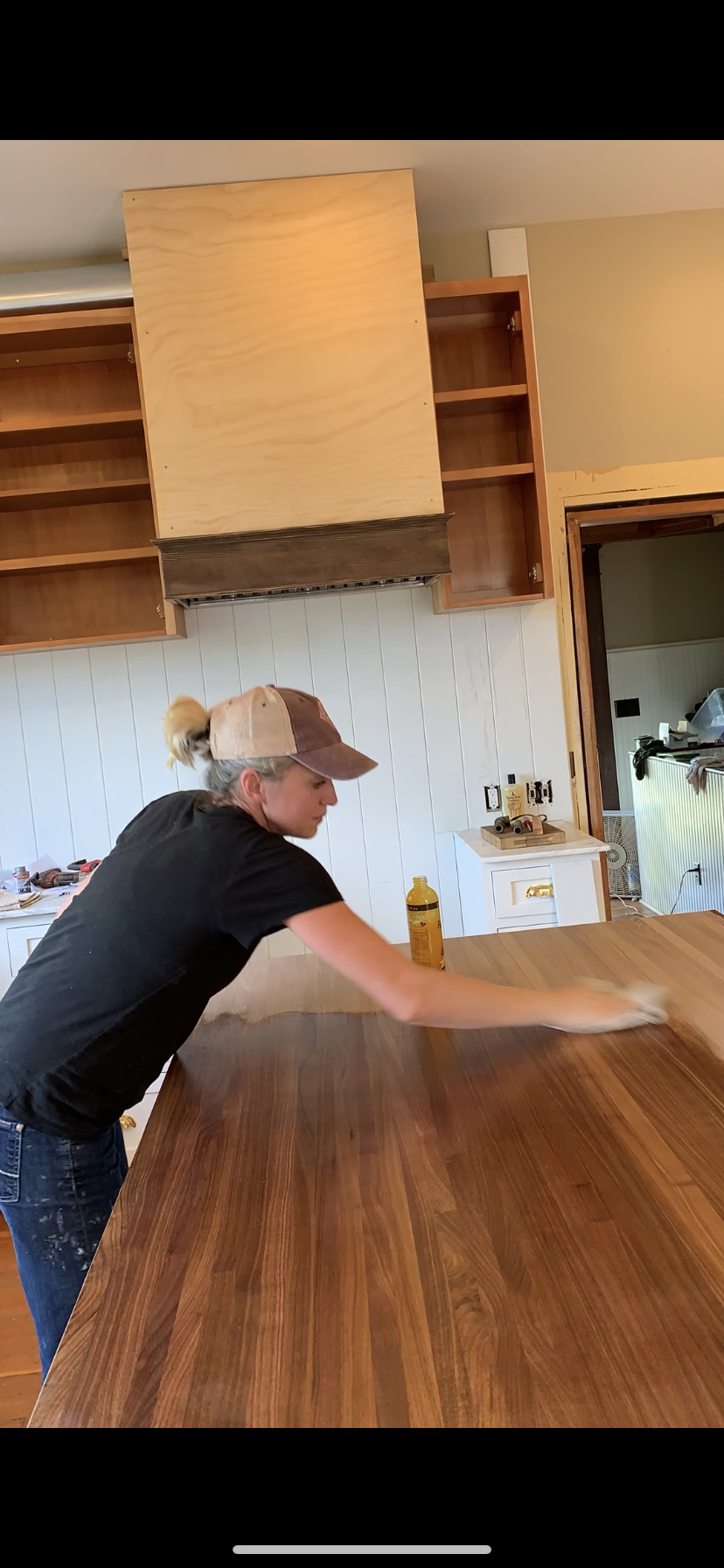Sanding butcher block countertops is a crucial step in maintaining their beauty and functionality. Butcher block, known for its warmth and natural appeal, is a popular choice for kitchens. Over time, these countertops can become scratched, stained, or dull. Regular sanding helps restore their original charm and ensures they remain a focal point in the kitchen. The process involves removing the old finish, smoothing out imperfections, and preparing the surface for re-sealing.
To begin sanding butcher block countertops, clear the surface of any items and clean them thoroughly. Any grease or debris left on the surface can interfere with the sanding process. A gentle scrub with soap and water, followed by a rinse and drying, prepares the countertop for sanding. For stubborn stains or stuck-on residue, a mixture of vinegar and water can be effective. Once cleaned, ensure the countertop is completely dry before proceeding.
Selecting the right sandpaper is essential for effective sanding. Start with a coarse-grit sandpaper, such as 80-grit, to remove old finishes and surface imperfections. This initial sanding phase will eliminate deep scratches and any unevenness. Attach the sandpaper to a sanding block or an orbital sander for even pressure. Sand in the direction of the wood grain to avoid cross-grain scratches, which can be difficult to remove.
After the initial coarse sanding, move to medium-grit sandpaper, like 120-grit. This stage further smooths the surface and begins to refine the texture of the wood. As with the coarse grit, sanding in the direction of the grain is crucial. The medium grit helps blend the rough sanding marks from the previous stage, making the surface smoother and more uniform.

The final sanding should be done with fine grit sandpaper, typically 220-grit or higher. This step provides a smooth finish, removing any remaining imperfections and preparing the wood for sealing. Fine grit sandpaper creates a polished surface, enhancing the natural beauty of the wood. Again, sand along the grain to maintain a consistent texture and avoid unwanted scratches.
Throughout the sanding process, it’s important to periodically check the surface for smoothness. Running your hand over the countertop can help identify any rough spots or remaining scratches. If needed, repeat the sanding process with the appropriate grit sandpaper until the surface is uniformly smooth. Dust should be wiped away between sanding stages to keep the workspace clean and to prevent it from interfering with the sandpaper.
After sanding, thorough cleaning is essential to remove all dust and debris. A vacuum with a brush attachment can effectively remove dust from the surface and any surrounding areas. Follow up with a tack cloth or a damp, lint-free cloth to wipe down the countertop. Ensuring the surface is free from dust particles is crucial before applying any finish, as dust can interfere with the adhesion of the sealant and leave a rough texture.

Choosing the right finish is the next important step after sanding. There are several options, including mineral oil, tung oil, or polyurethane. Each type of finish has its benefits. Mineral oil is food-safe and easy to apply but requires frequent reapplication. Tung oil offers a durable, water-resistant finish but can take longer to dry. Polyurethane provides a long-lasting, protective coating but is not recommended for surfaces used for direct food preparation.
Applying the finish should be done carefully and evenly. If using oil, apply it with a clean, lint-free cloth, rubbing it into the wood in the direction of the grain. Allow the oil to penetrate the wood, then wipe off any excess. Multiple coats may be needed, with drying time between each coat. For polyurethane, use a brush or a foam applicator to apply a thin, even coat. Allow it to dry completely before lightly sanding with fine grit sandpaper and applying additional coats.
Re-sealing butcher block countertops periodically is crucial to maintain their durability and appearance. The frequency of re-sealing depends on the type of finish used and the level of use the countertop receives. Generally, oil finishes need to be reapplied more frequently than polyurethane. Regular re-sealing helps protect the wood from moisture, stains, and scratches, ensuring it remains a functional and attractive surface.
Maintaining butcher block countertops between sandings involves regular cleaning and prompt attention to spills. Wipe the surface with a damp cloth and mild soap to remove daily grime. Avoid using harsh chemicals or abrasive cleaners, as they can damage the finish. For tougher stains, a paste of baking soda and water can be gently rubbed onto the stain, then wiped away. Keeping the surface clean helps prolong the life of the finish and reduces the need for frequent sanding.
Preventing damage to butcher block countertops is also important. Using cutting boards for food preparation can prevent knife marks and scratches. Hot pots and pans should be placed on trivets or hot pads to avoid heat damage. Avoid placing heavy or sharp objects directly on the surface to minimize the risk of dents and gouges. These preventive measures help maintain the integrity of the wood and reduce the frequency of necessary sanding.
When it comes to restoring old or heavily damaged butcher block countertops, more extensive sanding may be required. Deep scratches or significant stains might necessitate starting with an even coarser grit sandpaper. In some cases, planing the surface before sanding can remove significant damage. However, this should be done carefully to avoid removing too much material. Following up with standard sanding and re-sealing can bring the countertop back to life.
Sanding butcher block countertops is also an opportunity to refresh the overall look of the kitchen. By sanding and re-sealing, the natural beauty of the wood is enhanced, which can brighten up the space. Additionally, changing the finish, such as switching from an oil to a polyurethane, can alter the appearance and functionality of the countertop. This flexibility allows homeowners to adapt their countertops to evolving design preferences and needs.
Finally, understanding the characteristics of the specific wood used in the butcher block is important for effective sanding and maintenance. Different woods have different hardness levels and grain patterns, which can affect how they respond to sanding and finishing. Familiarity with the wood type helps in selecting the appropriate sandpaper grits and finishes, ensuring the best results and long-term satisfaction with the countertop.

Common Mistakes to Avoid
When sanding butcher block countertops, several common mistakes can affect the outcome and durability of the surface. One frequent error is not cleaning the countertop thoroughly before sanding. Any grease, dirt, or debris left on the surface can clog the sandpaper and cause uneven sanding. Cleaning the countertop well before starting the sanding process ensures a smooth and effective sanding experience.
Another mistake is using the wrong grit sandpaper or skipping grits. Starting with too fine a grit can make it difficult to remove deep scratches or stains, while skipping intermediate grits can leave the surface rough and uneven. It’s crucial to follow a systematic progression from coarse to fine grit to achieve a smooth finish. Each grit level prepares the surface for the next, ensuring a uniform and polished result.
Sanding against the grain is a common error that can lead to noticeable scratches and a rough surface. Always sand in the direction of the wood grain to maintain a smooth and even texture. Cross-grain sanding can create deep scratches that are difficult to remove, affecting the appearance and feel of the countertop.

Failing to clean the surface between sanding stages is another mistake. Dust and debris left on the countertop can interfere with the next stage of sanding and the application of finishes. Regularly vacuuming and wiping down the surface between sanding stages helps ensure a clean workspace and a smooth finish.
Choosing the wrong type of finish for the intended use of the countertop is a common issue. For surfaces used for direct food preparation, a food-safe finish like mineral oil or beeswax is recommended. Polyurethane provides a durable finish but is not food-safe and should not be used on surfaces where food will be directly prepared. Selecting the appropriate finish based on the use of the countertop ensures safety and durability.
Applying too much finish or not allowing adequate drying time between coats can lead to a sticky or uneven surface. It’s important to apply thin, even coats of finish and allow each coat to dry thoroughly before applying the next. Over-application can result in a surface that does not cure properly and can be difficult to use or clean.
Ignoring the need for regular maintenance after sanding and finishing is a mistake that can reduce the longevity of the countertop. Regular cleaning, prompt attention to spills, and periodic re-sealing help maintain the surface and protect it from damage. Neglecting these maintenance tasks can lead to the need for more frequent sanding and refinishing.

Why is sanding necessary for butcher block countertops?
Sanding butcher block countertops is essential for maintaining their appearance and functionality. Over time, these countertops can develop scratches, stains, or a dull surface due to regular use. Sanding removes the old finish, smooths out imperfections, and prepares the surface for re-sealing. This process restores the natural beauty of the wood and helps protect it from future damage, ensuring a durable and attractive countertop.
What type of sandpaper should I use for sanding butcher block countertops?
The sanding process typically involves three stages of sandpaper grits. Start with a coarse-grit sandpaper, such as 80-grit, to remove old finishes and deep scratches. Follow this with a medium grit, like 120 grit, to further smooth the surface. Finish with a fine-grit sandpaper, such as 220-grit or higher, to achieve a polished, smooth finish. Using the appropriate grit progression helps ensure a uniform and well-prepared surface for finishing.
How often should I re-seal butcher block countertops?
The frequency of re-sealing butcher block countertops depends on the type of finish used and the level of use. Oil finishes, such as mineral oil, typically require reapplication every few months or as needed based on the wear. Polyurethane finishes provide longer-lasting protection and may only need re-sealing every few years. Regularly inspecting the countertop for signs of wear and re-sealing as necessary helps maintain its durability and appearance.
What finishes are suitable for butcher block countertops used for food preparation?
For butcher block countertops used for direct food preparation, food-safe finishes like mineral oil or beeswax are recommended. These finishes protect while being safe from contact with food. Tung oil can also be used if it is specified as food-safe. Polyurethane should be avoided on surfaces where food is directly prepared, as it is not food-safe. Choosing the appropriate finish ensures both safety and durability for food preparation areas.
Can I sand and finish butcher block countertops myself, or should I hire a professional?
Sanding and finishing butcher block countertops can be a DIY project if you have the proper tools and follow the correct procedures. However, it requires careful attention to detail, including selecting the right sandpaper, sanding in the direction of the grain, and applying finishes properly. If you are unsure or uncomfortable with the process, hiring a professional can ensure a high-quality result. Professionals have the experience and tools needed to achieve a smooth, even surface and properly apply finishes.

DIY // How to Cut, Sand, Install, and Finish a Butcher Block

Related articles:
- Butcher Block Countertops With White Cabinets
- Pine Butcher Block Countertops
- Butcher Block Countertops Walnut
- Maple Butcher Block Countertops
- Care Of Butcher Block Countertop
- Butcher Block Countertops Maintenance
- Antique Butcher Block Countertops
- Butcher Block Countertop Sealing
- Wood Butcher Block Countertop
- Thick Butcher Block Countertop
